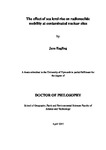The effect of sea level rise on radionuclide mobility at contaminated nuclear sites
| dc.contributor.supervisor | Worsfold, Paul J | |
| dc.contributor.author | Eagling, Jane | |
| dc.contributor.other | School of Geography, Earth and Environmental Sciences | en_US |
| dc.date.accessioned | 2013-01-22T11:59:03Z | |
| dc.date.available | 2013-01-22T11:59:03Z | |
| dc.date.issued | 2012 | |
| dc.date.issued | 2012 | |
| dc.identifier | 10047237 | en_US |
| dc.identifier.uri | http://hdl.handle.net/10026.1/1248 | |
| dc.description.abstract |
Global sea levels are expected to rise as a result of climate change, which will lead to the inundation and erosion of low lying coastal areas and accelerate the intrusion of seawater into sub-surface sediments. Many of the UK’s legacy nuclear facilities are located in close proximity to the shore, raising questions regarding the potential mobilisation of radionuclides during sea level rise. Here batch and column experiments were used to simulate and investigate the effect of these processes on the mobilisation of key radionuclides Tc, 90Sr and U from oxic and reduced sediments under sea level rise scenarios. Strontium-90 was rapidly mobilised from exchangeable surface sites from oxic sediments during inundation and erosion scenarios with seawater (≈ 60%). Strontium release was driven by ion exchange between Sr90 and Mg2+ cations present in high concentrations in seawater. Uranium release from oxic and reduced sediments was kinetically controlled, characterised by slow release from a range of binding sites, promoted by the formation of U-carbonate complexes. Uranium mobilisation was slower from reduced sediments compared with oxic sediments under seawater flow conditions; therefore reduced sediments would act as a longer term source of U to marine environments. Release was more extensive from initially nitrate reducing sediments (53%) compared with extensively iron reducing sediments (38%), with the difference in release explained by the longer contact period of U(VI) with the iron reducing sediment relative to the nitrate reducing sediment which would lead to slower desorption. Additionally, U(IV) species would be released more slowly than U(VI) species sorbed to the sediments. The release of Tc was dependent on sediment re-oxidation coupled with the oxidation of Tc(IV) to Tc(VII). Batch experiments showed that only a small proportion of Tc was rapidly (within 5 days) released from the sediments into seawater and groundwater which suggests that the majority of any Tc(IV) contamination will be released slowly as the seawater plume migrates through the sediments. Technetium release was slowest, and ultimately limited to the greatest extent (17%), in initially Fe-reducing sediments, when they were re-oxidised in seawater. Thus the cycling of iron and the impact of the water chemistry on iron mineralogy were important for hindering Tc release. Column experiments showed that iron minerals were less effective at retarding Tc release under flow-through conditions. Kinetically controlled and solubility limited Fe dissolution led to on-going Tc release from the sediments, i.e. the retarding effect of iron phases was temporary and significantly more Tc was mobilised (79-93%) compared with the batch experiments (17-45%). This study has shown for the first time that radionuclides will be released from reduced and oxic sediments as a result of future sea level rise. Contaminated sediments have the potential to act as a secondary source of radionuclide contamination entering the marine environment from coastal nuclear sites. This information is essential when siting new nuclear facilities and when developing effective remediation, decommissioning and management strategies for legacy coastal sites. | en_US |
| dc.description.sponsorship | National Environmental Research Council (NERC) | en_US |
| dc.language.iso | en | en_US |
| dc.publisher | University of Plymouth | en_US |
| dc.subject | Contaminated land | en_US |
| dc.subject | Porewater salinization | en_US |
| dc.subject | Radionuclide | en_US |
| dc.subject | Geochemistry | en_US |
| dc.subject | Release kinetics | en_US |
| dc.subject | Transport | en_US |
| dc.subject | Oxic and reduced sediments | en_US |
| dc.title | The effect of sea level rise on radionuclide mobility at contaminated nuclear sites | en_US |
| dc.type | Thesis | |
| plymouth.version | Full version | en_US |
| dc.identifier.doi | http://dx.doi.org/10.24382/3421 |
Files in this item
This item appears in the following Collection(s)
-
01 Research Theses Main Collection
Research Theses Main


